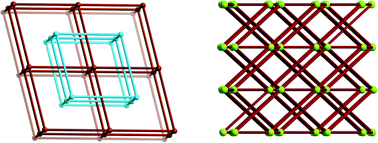Four new NiII and CoII complexes, [Ni(5-Br-ip)(bip)(H2O)]n (1), [Ni(5-Br-ip)(bib)]n (2), [Co(5-Br-ip)(bip)]n (3) and [Co(5-Br-ip)(bip)]n (4) (5-Br-H2ip = 5-bromoisophthalic acid, bip = 1,3-bis(imidazol)propane, bib = 1,4-bis(imidazol)butane), have been synthesized and structurally characterized by elemental analysis, IR and single-crystal X-ray diffraction. Complex 1 features a 2D double layer extended by the intermolecular hydrogen bonds between 2D layers. Complex 2 shows a 2-fold interpenetrating 3D → 3D network based on the dinuclear Ni(II) units. Complexes 3 and 4 can be regarded as supramolecular structural isomers. Isomer 3 possesses a 1D chain structure with binuclear Co units as subunits. Isomer 4 shows a 3D network and can be reduced to a 4-connected net with the (65.8) topology. The structural differences indicate that the backbone of the organic N-donor ligands and the nature of the metal ions play important roles in governing the structures of such metal–organic coordination architectures. Moreover, the magnetic properties of complexes 2 and 3 were also studied in 2–300 K.

You have access to this article
 Please wait while we load your content...
Something went wrong. Try again?
Please wait while we load your content...
Something went wrong. Try again?


 Please wait while we load your content...
Please wait while we load your content...